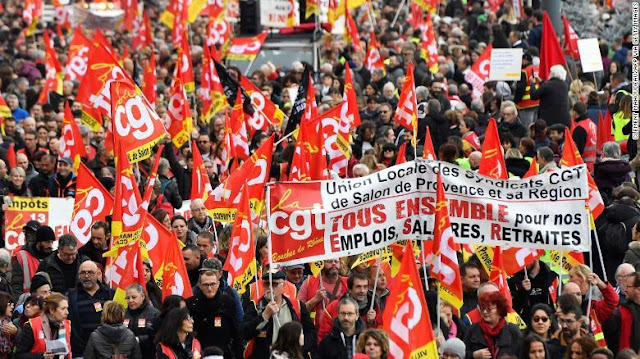The Dollar’s Future: Multilateral World, Multilateral Currency
Mujeeb Khan

French Protesters at NATO Summit

Unions call for protests in France over the high prices and pension
After World War II,
the United States Marshall Plan rebuilt the war-torn countries of Europe in a
truly brief period, and they became industrialized countries in the 1960s. for
seventy years, these countries had complete dominance over the world economy. The
world financial institutions were under their control. They had a monopoly on
commerce and trade. Now Ukraine war in the middle of Europe is rolling back 70
years of economic growth and prosperity in Europe. America is $31 trillion in
debt, and by 2030 it will increase to nineteen trillion dollars. America will
be the indebted superpower of the world. And Pakistan will be the most indebted
nuclear power in the world. Both countries will be sitting on the branch of
the fallen leaf tree and will look envious at the economic prosperity of those who
do not owe anyone. However, the effects of the Ukraine war are now felt in Europe’s
economy. Russia was a major trading partner of the European Union. By isolating
a major trading partner, European countries have harmed their economies. European
leaders and the United States believed that Russia would not be able to
withstand its severe economic sanctions and would soon compromise on a ceasefire.
But the Ukraine war has now entered its second year. Surprisingly, European
countries have opened a war front with nuclear power in Europe. Russia has
thousands of nuclear weapons. For Ukraine, Europe has made its enemy, but it
will not go to war with Russia.
Europe’s leaders are
particularly nervous about where the war in Ukraine will take them. In Europe,
public anxiety about the war in Ukraine is increasing. Inflated cost of living
and unemployment are the effects of this war that the people will face. There are
protests in France over raising the retirement age and the pension issue. There
is a protest in London over the rising cost of living. Germany, one of the
largest economies in Europe, is shrinking. German companies are moving to China,
according to reports from trade research institutes in Europe, 58,000 companies
will go bankrupt in France by the end of this year. US Treasury Secretary Janet
Yellen has said that “the hegemony of the dollar threatened by US sanctions on
Russia. Russia and Iran are looking to replace the dollar and China’s currency
the yuan is gaining ground against the US dollar. And this is one of China’s
it has long been ambitious to have its currency recognized in global trade. The
US’s restrictive sanctions policy has opened the door to trade in more than one
currency.
Saudi Arabia and the oil-producing countries
of the Gulf have also announced to trade in Chinese currency. Iran is already
trading with China and Russia in their currency. Brazil and Argentina have
decided to trade in their own currency. India has announced that countries that
cannot afford the dollar due to its high price can use Indian currency. On the
other hand, the trade between European Union countries is in Euro. The trend to gain
independence from the dollar-dominated world is growing. Trade in the region
and among regional countries in local currency is promoted. In addition to US
sanctions, there is pressure on the dollar from the increasing debts of the
US.
Today, Saudi Arabia
and Gulf countries are talking about payment of their oil in other currencies,
after the first Gulf War, Iraq’s President Saddam Hussein refused to accept the
payment of his oil in dollars. After him, Libyan President Gaddafi also refused
to receive oil payments in dollars. They were such visionary leaders that they
knew that one day the oil-producing countries would have to make this decision.

No comments:
Post a Comment